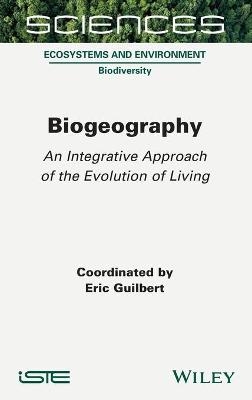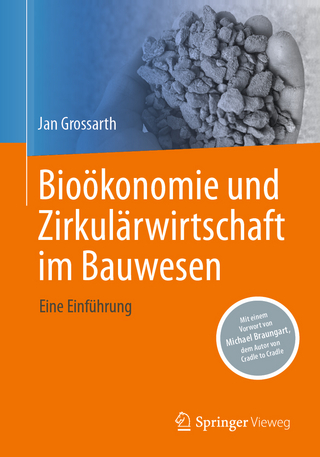
Biogeography
Iste Ltd (Verlag)
978-1-78945-060-6 (ISBN)
Originating with Alexander von Humboldt, biogeography is a discipline in which ecologists and evolutionists aim to understand the way that living species are organized in connection with their environments. Today, as we face major challenges such as global warming, massive species extinction and devastating pandemics, biogeography offers hypotheses and explanations that may help to provide solutions.
This book presents as wide an overview as possible of the different fields that biogeography interacts with. Sixteen authors from all over the world offer different approaches based on their specific areas of knowledge and experience; thus, we intend to illustrate the vast number of diverse aspects covered by biogeography.
Eric Guilbert is an entomologist at the National Museum of Natural History in France. His research covers how communities of species are organized and how they react to environmental changes.
Preface xi
Eric GUILBERT
Chapter 1 Origins of Biogeography: A Personal Perspective 1
Malte C EBACH
1.1 Introduction: a history of scientific practice 1
1.1.1 What is biogeography? 2
1.2 A history of phyto- and zoogeographical classification 2
1.2.1 Terminology 2
1.2.2 How classification works 3
1.2.3 Botanical geography versus the geography of plants 7
1.2.4 Zoogeography: a search for natural regions 12
1.3 Ecology versus taxonomy: populations not species 17
1.4 Conclusion 22
1.5 References 22
Chapter 2 Analytical Approaches in Biogeography: Advances and Challenges 27
Isabel SANMARTÍN
2.1 Introduction 27
2.2 From narrative dispersal accounts to event-based methods (EBM) 27
2.2.1 Parsimony-based tree fitting 29
2.2.2 Dispersal–vicariance analysis 31
2.3 From parsimony-based to semiparametric approaches 34
2.4 A new revolution: parametric approaches in biogeography 38
2.4.1 Ancestral range versus single state models: DEC and BIB 41
2.4.2 Extending the DEC and BIB models 47
2.5 Expanding parametric models 49
2.5.1 Time-heterogeneous models 49
2.5.2 Diversification-dependent models 50
2.5.3 Ecology-integrative models 51
2.6 Population-level and individual-based models 52
2.7 References 53
Chapter 3 Phylogeography 59
Inessa VOET and Violaine NICOLAS
3.1 Introduction 59
3.2 The early days of phylogeography: cytoplasmic genomes and qualitative post hoc explanations of historical processes 61
3.3 Statistical phylogeography 63
3.4 Comparative phylogeography 67
3.5 Integrative studies 69
3.5.1 Integration of ecological niche modeling in phylogeographic studies 69
3.5.2 Integration of life-history traits in phylogeographic studies 73
3.6 Conclusion 76
3.7 References 76
Chapter 4 Geophysical Biogeography 81
Laurent HUSSON and Pierre SEPULCHRE
4.1 Introduction 81
4.2 Geophysical biogeography at large 82
4.2.1 Present day 82
4.2.2 The dynamic Earth: continental drift 84
4.2.3 Continental drift and climate 87
4.2.4 The fast pace of mass extinctions 90
4.3 Geophysical biogeography at regional scale 92
4.3.1 Mountain belts and rifts 95
4.3.2 Epeirogenies, dynamic topography 99
4.3.3 Glacial cycles 100
4.4 Conclusions 104
4.5 References 105
Chapter 5 Island Biogeography 115
Julia SCHMACK and Matthew BIDDICK
5.1 The equilibrium theory of island biogeography 116
5.2 Insularity and the evolution of emblematic biotas 120
5.3 Island biogeography in the Anthropocene 123
5.3.1 Biological invasions 124
5.3.2 Anthropogenic climate change 127
5.4 References 128
Chapter 6 Cave Biogeography 143
Arnaud FAILLE
6.1 Physical characteristics of subterranean environments 143
6.2 Diversity and adaptations of the cave fauna 144
6.2.1 Underground evolution 144
6.2.2 Diversity 145
6.3 Vicariance and dispersal shape the global distribution patterns of cave animals 148
6.3.1 Disjunct distributions and the relictual status of cave biota 148
6.3.2 Colonization of the subterranean environment: reassessing biogeographic hypotheses 152
6.4 Perspectives in subterranean biogeography 154
6.5 Acknowledgments 156
6.6 References 156
Chapter 7 Soil Bacterial Biogeography at the Scale of France 165
Battle KARIMI and Lionel RANJARD
7.1 Introduction 165
7.2 Soil bacterial communities 166
7.2.1 Abundance, diversity and role 166
7.2.2 Molecular tools to characterize bacterial communities 167
7.2.3 Genesis of microbial biogeography 168
7.3 Soil survey networks around the world 169
7.3.1 The French Monitoring Network of Soil Quality 170
7.4 Bacterial alpha- and beta-diversity at the national scale 172
7.4.1 Bacterial alpha-diversity 172
7.4.2 The bacterial taxa–area relationship 173
7.5 Spatial distribution and ecological attributes of bacterial taxa at a large scale 176
7.6 Large-scale bacterial co-occurrence networks (also called Bacteriosociology) 179
7.7 Do large-scale bacterial habitats exist? 181
7.8 Biogeography at the service of environmental diagnosis 185
7.9 Conclusion perspectives 186
7.10 References 187
Chapter 8 Fungal Biogeography 193
Tarquin NETHERWAY and Mohammad BAHRAM
8.1 Introduction 193
8.2 Fungal evolutionary history 195
8.3 Biogeographic patterns 196
8.3.1 Distance-decay of similarity and species area relationship 197
8.3.2 Latitudinal diversity patterns 198
8.3.3 Altitudinal diversity patterns 199
8.4 Functional and interactional biogeography of fungi 199
8.4.1 Functional biogeography of fungi 200
8.4.2 Interactional biogeography of fungi and plants 201
8.4.3 Interactional biogeography of fungi and animals 205
8.4.4 Interactional biogeography of fungi and bacteria 206
8.5 Fungal biogeography under global environmental change 207
8.6 The role of citizen science in the study of fungal biogeography 208
8.7 Future directions 208
8.8 References 209
Chapter 9 Freshwater Biogeography in a Nutshell 219
Anthi OIKONOMOU
9.1 Introduction 219
9.2 Freshwater hotspots and patterns in species richness 220
9.2.1 Latitudinal gradient in species richness 220
9.2.2 Geography, environment and biogeographical history 221
9.2.3 Species–area relationship (SAR) 223
9.2.4 Community assembly in freshwater 224
9.2.5 Local scale 225
9.2.6 Metacommunity concept 227
9.2.7 Beta diversity 230
9.3 Conclusion 232
9.4 Acknowledgments 232
9.5 References 233
Chapter 10 Marine Biogeography 245
Jorge GARCÍA MOLINOS and Irene D ALABIA
10.1 Introduction 245
10.2 Diversification in the oceans 247
10.3 Diversity gradients in the oceans 253
10.3.1 Latitudinal diversity gradients 253
10.3.2 Bathymetric diversity gradients 258
10.3.3 Compositional diversity gradients 259
10.3.4 Functional and phylogenetic diversity gradients 260
10.4 Conclusions 263
10.5 References 264
Chapter 11 Biogeography of Diseases 275
Jesús OLIVERO
11.1 Introduction 275
11.1.1 The need of disease mapping for management and prevention policies 275
11.1.2 Hypotheses on which biogeography sustains the analysis of infectious diseases 276
11.2 Do microbes have their own biogeography? 277
11.3 Historical biogeography and disease 279
11.4 Disease distribution patterns 281
11.5 Disease distribution modeling 282
11.5.1 Mechanistic versus empirical modeling 282
11.5.2 The search for risk factors in time and space 283
11.5.3 Pathogeography: addressing the multifaceted analysis in disease mapping 289
11.6 Concluding remarks 292
11.7 Acknowledgements 293
11.8 References 293
Chapter 12 Biogeography and Climate Change 303
Luisa Maria DIELE-VIEGAS
12.1 Climate change 303
12.1.1 Drivers of climate change 305
12.1.2 Observed changes in the climate system 305
12.1.3 Future projections of global climate change 307
12.2 Impacts of climate change on biodiversity 308
12.2.1 Recent impacts 309
12.2.2 Future impacts 311
12.3 References 313
Chapter 13 Conservation Biogeography: Our Place in the World 321
Brett R RIDDLE
13.1 The emergence of conservation biogeography 321
13.2 Milestones in the development of conservation biogeography 322
13.3 The purview of conservation biogeography: claimed and examined 325
13.4 Has conservation biogeography provided unique contributions to biodiversity conservation? 329
13.5 Future directions 330
13.6 References 331
List of Authors 335
Index 337
| Erscheinungsdatum | 27.01.2022 |
|---|---|
| Verlagsort | London |
| Sprache | englisch |
| Maße | 10 x 10 mm |
| Gewicht | 454 g |
| Themenwelt | Naturwissenschaften ► Biologie ► Ökologie / Naturschutz |
| Naturwissenschaften ► Geowissenschaften ► Geografie / Kartografie | |
| ISBN-10 | 1-78945-060-8 / 1789450608 |
| ISBN-13 | 978-1-78945-060-6 / 9781789450606 |
| Zustand | Neuware |
| Haben Sie eine Frage zum Produkt? |
aus dem Bereich


